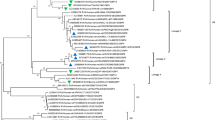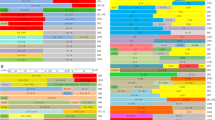Summary.
Extensive heterogeneity in electropherotypes observed among group A human rotaviruses has been considered as a result of two major mechanisms; i.e., the accumulation of point mutations and genetic reassortment between concur-rently-circulating strains. However, no evidence was reported thus far indicating that any one of field isolates of rotavirus was formed by direct reassortment of concurrently circulating two parental strains. Comparison of the genome of human rotavirus specimens collected over a six year period by electropherotyping and by the sequencing of selected gene segments identified two reassortants that were generated in nature between strains circulating co-dominantly in the same epidemic season. This is the first report directly showing that at least some part of electrophoretic diversity observed among rotavirus strains was explained by genetic reassortment between strains concurrently circulating in the human population. This supports the hypothesis that genetic reassortment among co-circulating strains operates as a key mechanism for the genetic variability of rotaviruses in nature.
Similar content being viewed by others
Author information
Authors and Affiliations
Additional information
Received September 6, 1999 Accepted August 3, 2000
Rights and permissions
About this article
Cite this article
Watanabe, M., Nakagomi, T., Koshimura, Y. et al. Direct evidence for genome segment reassortment between concurrently-circulating human rotavirus strains. Arch. Virol. 146, 557–570 (2001). https://doi.org/10.1007/s007050170162
Issue Date:
DOI: https://doi.org/10.1007/s007050170162




